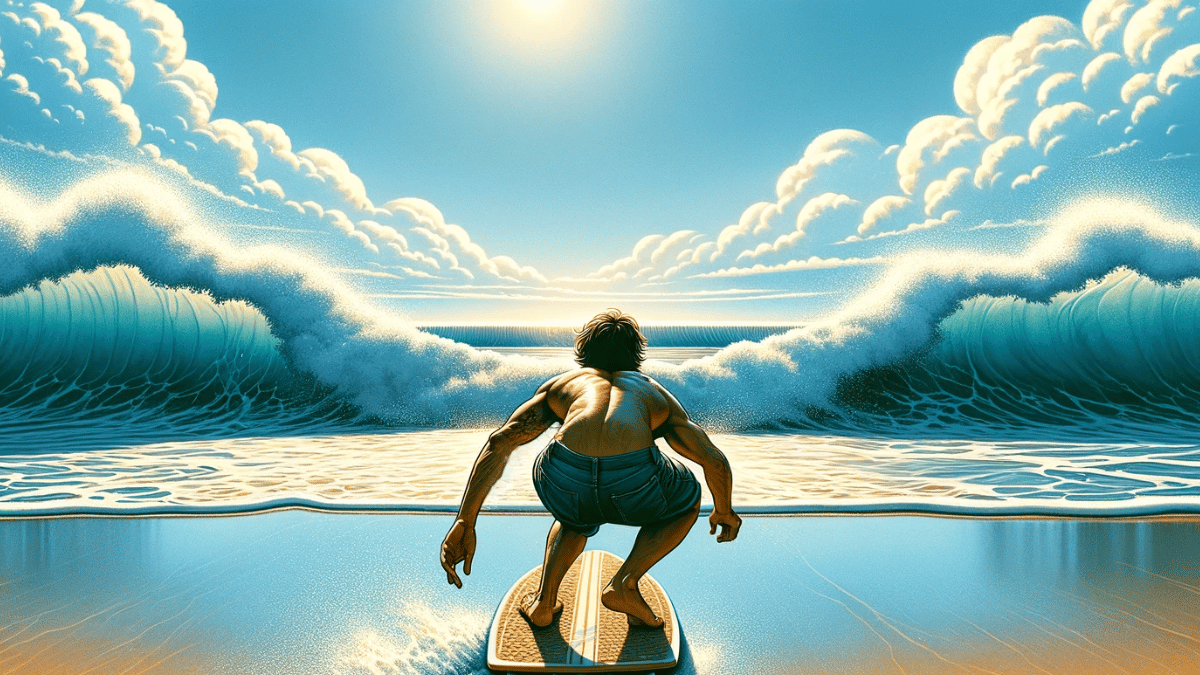Imagine stepping onto a board where the ocean meets the sand and gliding your way into an incoming breaking wave. This is skimboarding, where skill, balance, and the thrill of riding the water’s edge come together in perfect harmony.
Skimboarding promises a fun and engaging way to enjoy your next beach outing. It’s one of over 50 energizing activities that we recommend for your leisure stack.
This article will teach you how to skimboard, detailing three crucial steps: finding the perfect spot, mastering the board throw, and learning the art of stepping onto the board seamlessly.

Find the Perfect Spot for Skimboarding
To embark on your skimboarding journey, start with these key points in finding the ideal location:
- Flat and Smooth Sand: Look for a stretch of beach with flat, smooth sand. This provides the best surface for skimboarding.
- Shallow Water: Aim for areas where the water is about an inch deep. Too deep, and you risk slowing down; too shallow, and you might not glide at all.
- Avoid Obstacles: Steer clear of rocks, debris, or any obstacles that could interrupt your glide or pose safety risks.
- Small Waves: If possible, find a spot with consistent, small waves that can carry you back to shore for an added thrill.
Master the Board Throw
Perfecting the board throw is essential for a successful skim. Follow these steps to master it:
- Grip: Hold the board with your dominant hand at the back and your other hand near the front.
- Approach: Walk towards the water’s edge, then bend your knees slightly and lean forward.
- Swing and Release: Swing the board low to the ground, releasing it parallel to the water surface for a smooth glide.
- Balance Your Throw: Ensure your throw isn’t too hard (making the board hard to catch) or too soft (not enough momentum).
Learn to Step onto the Skimboard
Mounting the skimboard correctly is crucial for maintaining momentum. Here’s how to do it:
- Practice on Sand: Before hitting the water, practice stepping onto the board on sand to get the feel of the motion.
- Step, Don’t Jump: Gently step onto the moving board to avoid sinking. Start with your non-dominant foot just past the middle, then bring your dominant foot behind.
- Foot Position: Your feet should be slightly turned sideways to help with balance and control.
- Smooth Motion: The key to a successful ride is a fluid motion that leverages your forward momentum.
Watch the “How to Skimboard” Video Tutorial
The following video by NateTube shows how you can learn skimboarding fast. Check it out:
Watch the Pros Skimboard
Skim Kids has a compilation of the best skimboarding waves that they captured at Aliso Beach in Laguna Beach, California. Check it out:
The Instagram channel @skimboardings also has some great videos of skimboarding pros. Here’s a popular one:
Choosing the Right Skimboarding Equipment
Selecting the appropriate skimboarding gear is important for beginners. Here’s a breakdown of the essential equipment to get you started on your skimboarding adventure:
- Wooden Skimboard: Ideal for beginners, wooden boards are great for sliding on the sand and learning basic foot placement. They are heavier and slower, perfect for getting a feel for the sport.
- Foam Skimboard: A step up from wooden boards, foamies are lighter and better for riding waves. They provide a good balance between stability and maneuverability, making them suitable for intermediate riders.
- Traction Pads: Essential for grip, traction pads should be placed on the tail and halfway up the board. They help maintain foot placement during tricks and turns.
- Board Wax: Applied from the tail pad up towards the nose, wax ensures your feet can grip the board securely, regardless of where they land.
- Appropriate Clothing: For warm conditions, board shorts and sunblock are sufficient. In cooler weather, a wetsuit top can protect against wind and cold, while a full wetsuit is recommended for very cold conditions.
With the right equipment, you’ll be well on your way to mastering the art of skimboarding.
Glide, Grow, and Conquer the Waves
Skimboarding combines the thrill of surfing with the technique of skateboarding, all while being uniquely accessible and enjoyable at the beach. By following these steps and dedicating time to practice, you’ll enhance your skimboarding skills and enjoy the exhilarating sensation of gliding along the interface of ocean and sand. Remember, patience and persistence are your best allies on this journey.
Skimboarding is very versatile. I've seen it done in the ocean, on wet grass, over canals, through reflection pools, on ice, over snow, and even in long indoor inflatable pools. Where would you skimboard?
— Leisure Editor (@leisureeditor) March 11, 2024
[📹 blairconklin] pic.twitter.com/obAagrVunX

